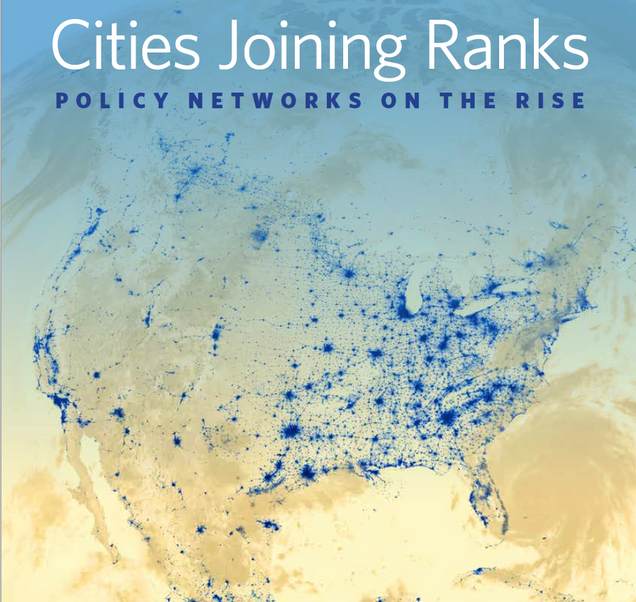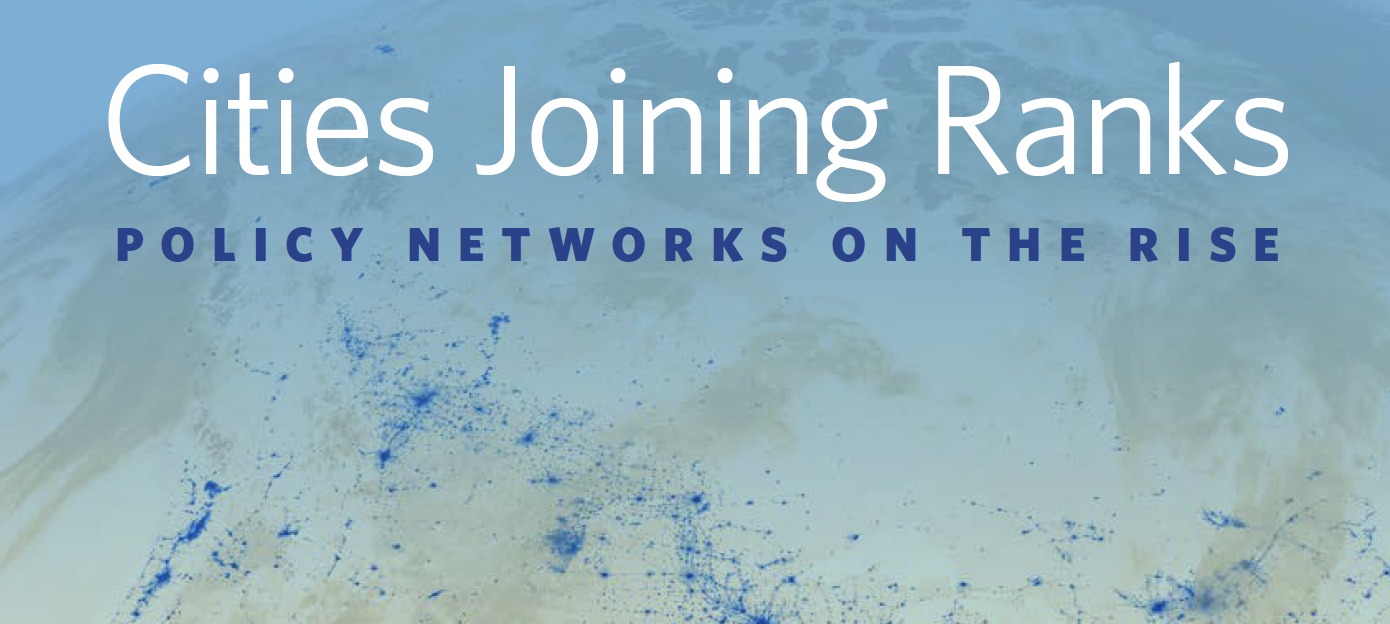 On Monday, April 23rd, 2018, the Boston University Initiative on Cities, with support from Citi Community Development and The Rockefeller Foundation, launched Cities Joining Ranks—Policy Networks on the Rise, a new report which details the activities, visibility, value, and membership of city-to-city policy networks, and provides the first evaluation of city peer groups based on joining behavior.
On Monday, April 23rd, 2018, the Boston University Initiative on Cities, with support from Citi Community Development and The Rockefeller Foundation, launched Cities Joining Ranks—Policy Networks on the Rise, a new report which details the activities, visibility, value, and membership of city-to-city policy networks, and provides the first evaluation of city peer groups based on joining behavior.
Report findings show big cities on average are part of more networks: 44 of the 50 largest US cities are in two or more of the 15 networks and the largest population centers—including New York City, Los Angeles, Chicago, Houston, and Philadelphia—participate in seven or more networks. The most highly networked cities are not exclusively the biggest: Boulder, CO; Pittsburgh, PA; New Orleans, LA; and Berkeley, CA are among the 13 most active joiners of the environmental networks; and Akron, OH and Richmond, VA are among the most engaged in non-environmental policy networks.
The analyses included in the report are based on a number of original data sets and sources, including a nationally representative survey of American mayors, network membership rolls, interviews with network representatives, and supplemental information from online sources.
The proliferation of policy networks in the United States (US), particularly in the environmental domain, has provided new opportunities for cities and mayors to unite around common causes. Over half of all US cities with populations over 75,000 are members of at least one of the 15 networks highlighted in this report.
“At 100 Resilient Cities, we’ve seen the importance of connecting cities together to foster collaboration and learning,” said Andrew Salkin, Senior Vice President of City Solutions at 100 Resilient Cities—Pioneered by The Rockefeller Foundation. “Time and time again, cities in our network have leveraged expertise from other cities—importing and exporting knowledge from both successes and failures—to ensure that cities aren’t recreating the wheel when faced with a problem that another city may already have experience with.”
“Many of the most complex issues, such as climate change and affordable housing, transcend municipal borders and are impacting cities across the country,” said Bob Annibale, Global Director of Citi Community Development and Inclusive Finance. “The Cities Joining Ranks report offers unique visibility into the challenges mayors of cities, large and small, are tackling, and how many are sharing responsibility and collaborating to find solutions through city networks.”
Mayors join networks because they believe they provide strength in numbers, act as a potent signal to their constituents, and afford opportunities to share best practices and exchange of information. In addition, mayors are often incubating policy networks—eight of the 15 networks studied were created by mayors, for mayors, suggesting a remarkable level of activism, leadership, and policy entrepreneurism that extends beyond city boundaries.
“With cities now the vanguard of problem solving in the United States, networks of cities have become the mechanism for sharing innovations, accelerating their adoption, and enabling communities to come together and exercise collective market and civic power,” says Bruce Katz, co-author of The New Localism: How Cities Can Thrive in the Age of Populism. “This report on urban networks is a critical contribution in a world that increasingly relies on horizontal connections between cities rather than hierarchical dictates from higher levels of government to make progress.”
The report also suggests a strong relationship between the ideology of a city’s residents and the number of environmental networks to which a city belongs: while cities that vote democratic are more likely to join multiple environmental networks, very few cities in which republican presidential voters comprise half or more of all voters belong to more than one (if any) environmental network. Mayors who have joined environmental networks report a considerably higher level of political agency to counteract federal climate policies relative to mayors who haven’t joined.
Fifteen active city networks with strong name recognition and engagements were selected for the study (10 of which focus on the environment, such as C40 or We Are Still In).
“At a time when we lack broad consensus about how to address challenges facing our cities and their residents, this important research highlights how mayors are increasingly partnering with city networks to help address climate change, economic mobility, and inclusion,” said Ryan Whalen, Managing Director of Global Partnerships for The Rockefeller Foundation.
“Mayors are acting to fill the gap left by lack of leadership on key issues nationally,” said Graham Wilson, Director of the BU Initiative on Cities. “They are increasingly coming together in networks to share knowledge, challenge each other to do more, and multiply their impact. This path breaking research tells us about when and why mayors come together in networks and the conditions for success.”
The report explores city network space in the US by addressing three guiding questions: How do city policy networks in the US compare to one another? Which US cities join which networks? Why do mayors sign on to networks?
Additional key findings of the report – which can be read in full at www.surveyofmayors.com – are below.
WHY MAYORS SIGN ON TO NETWORKS
Mayors cite a range of reasons for joining city-to-city networks and compacts, primarily focusing on the signaling power that network membership affords.
- Rationale for Joining: The primary reasons mayors join networks include the opportunity to amplify their message by uniting around common interests (32 percent), signal to their local constituents that they share a particular priority (25 percent), and exchange best practices or other information with peer cities (23 percent). 14 percent of mayors also report that network alliances are in response to a perceived leadership vacuum on related issues.
- Sense of Agency: Mayors that have joined environmental city networks are significantly more likely to feel a sense of agency, relative to non-member mayors, to counteract current federal policies on climate change.
HOW NETWORKS COMPARE
The networks vary in meaningful ways in regard to whom they serve, how they started, and what they do. All are designed to be public-facing; they engage in media outreach and frequently advocate with other levels of government on behalf of members.
- Activities: Networks are chiefly focused on helping to amplify city priorities, foster city-to-city connections, and build local capacity. The most frequent activities they undertake include media outreach (15 of the 15 networks), conferences and convenings (14/15), best practice-sharing (13/15), advocacy (13/15), and technical assistance (12/15).
- Visibility: Climate networks, in particular, have enjoyed an uptick in media coverage in recent years. The C40 Cities Climate Leadership Group is featured most frequently among all environmental networks, garnering one of every three related references in online media outlets in 2017.
- Origins: Further distinctions relate to the network founders, as eight of the 15 networks were initiated by mayors for mayors. Rather than only incubating local policies, mayors are creating new channels to connect, sharing ideas and elevating issues ranging from gun violence to broadband adoption.
WHICH CITIES ARE JOINING
59 percent of all US cities with populations over 75,000 participate in at least one of the 15 networks. In the environmental space, 41 percent of sample cities participate in at least one of the 10 related networks reviewed here, collectively representing 66.6 million US residents.
- City Connectivity: A social network analysis of membership rolls reveals clusters of cities which have similar membership profiles as well as even more tightly connected cliques of cities with identical memberships. Seven groups of five or more cities have identical environmental network memberships, suggesting similar values or levels of environmental advocacy and ambition.
